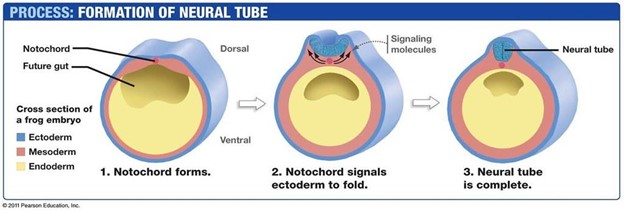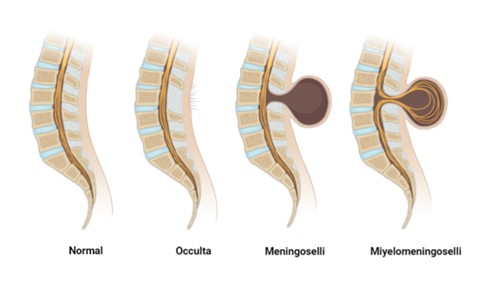
When the Neural tube fails to close or develop properly, the spinal cord can be damaged because it is unprotected, causing physical and intellectual disabilities.
Image Credit: aymanz.13/Creative Commons
What is the most common, permanently debilitating birth effect? Affecting approximately 166,000 individuals across the United States, spina bifida, which in Latin, literally translates to “split spine,” is a neural tube defect that causes damage to the spine. The condition can happen anywhere along the spine where neural tubes do not close all the way so that the backbone does not develop and protect the spinal cord. Spina bifida causes disabilities that can be intellectual and physical and range from mild to severe. Referred to as a “snowflake condition” because no two cases of the defect are the same, severity of spina bifida depends on the size and location of the spinal opening and whether part of the spinal cord or nerves are affected.
There are three common types of spina bifida: Myelomeningocele, Meningocele, and Spina Bifida Occulta. Myelomeningocele is the most serious case of spina bifida, and the one most people refer to when talking about the condition. In Myelomeningocele, a sac of fluid containing parts of the spinal cord and nerves, comes out of an opening in the back. Seventy to ninety percent of children with Myelomeningocele also have too much fluid in their brains because the fluid protecting the brain and spinal cord is unable to drain. Disabilities associated with this form of spina bifida include loss of feeling in the legs or feet, inability to move the legs, and problems with the bladder. Meningocele is a more moderate form of the condition where a sac of fluid comes out of the back but does not contain the spinal cord or nerves. The disabilities associated with meningocele are usually minor, and many people do not have symptoms at all. The final form of spina bifida, occulta, is sometimes referred to as “hidden spina bifida” because there are no visible signs of the condition. In fact, fifteen percent of healthy people have spina bifida occulta and do not even know it.

There are three common types of spina bifida: Occulta (a small gap in the spine where the spinal cord and nerves are normal), Meningocele (a sac of fluid comes through an opening in the back, but there is little nerve damage), and Myelomeningocele (parts of the spinal cord and nerves come out of the back in a sac of fluid causing moderate to severe disabilities).
Image Credit: Mirana Gavami/Creative Commons
Spina bifida is usually diagnosed during pregnancy or at birth. In utero, it can be detected using multiple kinds of tests. Blood tests in the 16th to 18th week of pregnancy can screen for high amounts of alpha-fetoprotein passing into the mother’s bloodstream from the baby, which may be an early indicator of the condition. Ultrasounds frequently detect spina bifida and can show signs of it such as the open spine. Finally, amniocentesis, where the doctor takes a small sample of amniotic fluid, can detect the defect by analyzing the amount of alpha-fetoprotein in the womb.
People with milder forms of spina bifida have a normal life expectancy, though severe forms of the disease may shorten life expectancy. Although people living with spina bifida face some challenges with their health needs, there are special accommodations that can help them manage their day to day lives. In terms of managing their physical health, people with the condition can find specialized doctors and stay in contact with healthcare professionals. To get exercise, they can roll or walk in their neighborhood, lift weights, or participate in sports teams for people with or without disabilities. Many people with spina bifida are unable to drive safely. However, a driver rehabilitation evaluation specialist can help identify modifications to cars that suit the needs of someone with spina bifida. People with the condition can also use buses, cabs, and other ride-sharing services.
Though there are not any clear answers to what causes spina bifida, the condition can be treated with surgery. Prenatal repair of myelomeningocele (MMC) is a surgical procedure that opens the uterus and closes the opening in the fetus’ back before birth. This helps prevent further damage since spinal cord damage is progressive during pregnancy. Though the surgery is not a cure, it offers better results than postnatal repair, or repair that happens after the baby is born. Fetal surgery also improves mobility and the chances that a child will be able to walk independently. There are also some preventative measures mothers can take to protect against spina bifida in their children. Research has shown that women should take folic acid before and during the first three months of pregnancy, which can help decrease the risk of birth defects.
Sources:
- https://www.spinabifidaassociation.org/what-is-spina-bifida-2/
- https://www.chop.edu/treatments/fetal-surgery-spina-bifida/about
- https://www.cdc.gov/ncbddd/spinabifida/facts.html#types
- https://www.nichd.nih.gov/health/topics/spinabifida/conditioninfo/diagnose